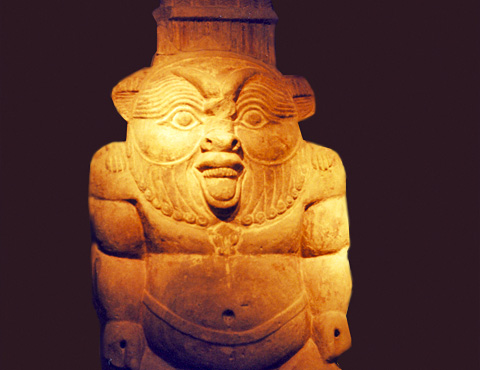Qarat Qasr Salim
The capital town of Bahariya in ancient times was located in the area which today is known as el-Qasr (Qarat Qasr Salim) on the north-eastern side of Bawiti.
The ancient name for the town was Psobthis and it spread around a temple whose one large remaining stone wall can still be seen, though numerous other ancient monuments probably still lie buried beneath the village.

Qarat Qasr Salim
The earliest evidence of the Pharaonic Period found so far in Bahariya is at Qarat el-Hilwa, where a group of tombs are cut into a sandstone ridge, about 3km south of el-Qasr, which may have been the cemetery of the ancient capital.
The oldest tomb and the only decorated one belongs to Amenhotep, ‘Governor of the Northern Oasis’ during late Dynasty XVIII or early Dynasty XIX and this is the only evidence in Bahariya from the New Kingdom.
The tomb of Amenhotep
consists of a forecourt which was decorated with scenes of the tomb-owner conducting his duties as a native governor, with his wife Ourly and son Menna.
Two more chambers include traditional funerary scenes similar to those seen in Theban tombs from the period.
Since Ahmed Fakhry recorded the tomb in 1938 (badly damaged even at that time) many of the wall scenes have suffered from the effects of weather and neglect – some have completely disappeared and the roof has also gone.
Many reliefs can still be seen, however, in blocks crudely rebuilt and consolidated with mortar, but it is in urgent need of proper restoration.
In the town of el-Qasr, a stone chapel inscribed for King Apries of Dynasty XXVI was built by two governors of the oasis named in the inscriptions, Wahibrenefer and Djedkhonsu-ef-ankh. An alabaster statue of the latter individual was discovered in the streets of el-Qasr in 1900 and is now
in the Cairo Museum.
King Apries’ name is inscribed on the wall of the chapel with a dedication text to Amun-Re ‘Lord of the Great Hill’ (an unusual title for the god, seen only in this oasis) and Khons.
The third member of the Theban Triad, Mut, does not seem to be mentioned here.
Also in the centre of el-Qasr are the remains of a mud-brick, probably Late Period, temple which was found by local residents in 1988 and recently investigated by the Egyptian Antiquities Organisation.
Although uninscribed, it is identified as having been dedicated to the dwarf-god Bes, from the artefacts found there.
One of the objects unearthed there is a well-preserved freestanding limestone statue of Bes, 1.37m high, which was a focal point of the Cairo Museum’s Centenary Exhibition.

The ancient town of Psobthis extended from the area around the temple in el-Qasr to the spring of Ain el-Muftillah, about 3km to the west.
The spring was probably the old capital’s main water-source but now this area of the site is part of the desert and enclosed within a fence, although fragments of houses and a scattering of pottery sherds can still be seen.
Near here, Steindorff uncovered the wall of a chapel in 1901, also bearing the name of King Amasis, which was excavated in 1938-39 by Ahmed Fakhry.
A short distance away Fakhry found three more chapels, with parts of walls covered in religious scenes and representations of several deities.
All of the chapels were decorated and date to Dynasty XXVI.
One of them (chapel 3) was built by Djedkhonsu-ef-ankh and was undoubtedly dedicated to a cult of Bes, whose temples are very rare.
The style of reliefs in chapel 1 are similar to the shrines of the divine adoratrices at Medinet Habu at Thebes, while chapel 2 was dedicated to Osiris with some unusual cult standards.
Excavations by the Egyptian Antiquities Organisation in 1977 showed that the four separate chapels excavated by Fakhry were actually part of a substantial temple structure which contained an early example of a pronaos.
The temple
was built during the reign of Amasis by the governors Djedkhonsu-ef-ankh and his brother Shebenkhonsu.
The chapels are now conserved under a wooden ceiling and a mound of sand for protection.
In Roman times the Triumphal Arch must have looked magnificent resting on its platform and towering high above the plain to greet travellers to the oasis.
Cailliaud drew and described it in 1820 when it was still in a good state of preservation, its façades ornamented with pilasters, it was by far the most imposing ruin in el-Qasr.
Sadly, today the arch is mostly destroyed, many of its stones re-used in nearby buildings.
What remains there are can be seen in situ,
on the left hand side of a lane which runs down from the ruined part of the old town, tucked into one of the gardens behind a fence with an iron door.
The platform still stands almost 10m high, but the arches and columns have now collapsed into ruins.
Nothing is known of the builder of the Arch of Triumph, but it is presumed Roman on architectural grounds and was probably part of the larger Roman fortress from which el-Qasr takes its name.
